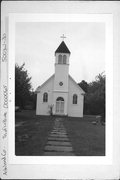| Additional Information: | ROUND ARCH WINDOWS, CENTRAL SQUARE STEEPLE OVER ENTRY,ROSE WINDOW DATE UNKNOWN, BUT EVIDENCE OF BLEND OF ROMANESQUE REVIVAL & GREEK REVIVAL
Historical Background
In 1835, an Austrian priest, father Frederic Baraga founded a church on Madeline Island. The priest had been impressed with reports he had heard of the Protestant minister, Reverend Sherman Hall's success with his mission and school on the island. Although he was already working in the Upper Great Lakes area, Father Baraga pleaded to be given an assignment at La Pointe, where the Native Americans had apparently requested a Catholic priest. Permission from his bishop and the government, which licensed missionaries, was slow in coming, so Baraga set out for the Island with neither. Within two weeks, Catholics on the Island helped him to construct a log church just south of the Indian Cemetery.
Father Baraga's enthusiasm however, prevented him from receiving governmental funds for his mission since Reverend Hall's sanctioned mission was established first, and the government would sponsor only one per area, so as not to "confuse" the Indians. Nonetheless, the Catholic congregation apparently grew steadily, since by 1841, it was necessary to build a new and larger church. This was located on the same site as the present Catholic Church. Father Baraga left Madeline Island in 1843 to take a new post at L'Anse, Michigan; however, his church and congregation apparently continued their practice. When the church Father Baraga built in 1841 burned down in 1901, the Catholics on the island quickly replaced it with the present structure: St. Joseph's Catholic Church at 266 E. Ojibiwa [42-5].
Historical Significance
St. Joseph's Catholic Church is significant under Criterion A of the Natonal Register of Historic Places for its association with the Jesuits and the Catholic Church on Madeline Island. The Jesuit mission to the American Indians was one of two on Madeline Island in the early 1800s. It was one early source of European influence on the Island's settlement.
Description
This gable front vernacular church with a centered steeple and gothic details was constructed in 1901. [A] The building is three bays wide and four bays deep. The gable main roof and pyramidal steeple roof are clad in asphalt while the walls are clad in clapboard. Simple in design, gothic-influenced details are evident in the round-arched widows, in the trim on the steeple base and in the tower vents.
Architectural Significance
St. Joseph's Catholic Church is significant under Criterion C of the National Register of Historic Places as a representative example of a vernacular church with gothic revival-influenced details. It is an excellent example of the craftsmanship of Island residents.
|
|---|
| Bibliographic References: | Construction Date: 1901 [MIHPA]
690 Bibliographic References
A. "Visit Historic Lake View School Museum on Madeline Island," Walking tour brochure, privately printed, Madeline Island Historic Preservation Association, LaPoint, Wisconsin, undated. |
|---|

